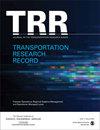一种基于物理的碰撞回波信号自动分类方法在已知缺陷混凝土板上的验证
IF 1.8
4区 工程技术
Q3 ENGINEERING, CIVIL
引用次数: 0
摘要
冲击回波(IE)能够从混凝土板对机械冲击的振动响应中定位混凝土板的地下缺陷。对于完整的板坯(“良好”状态),IE的频谱由与板坯“厚度共振频率”对应的单峰主导,而存在的表面缺陷(“一般”或“差”状态)可能以各种方式表现出来,例如在频率高于或低于厚度共振的频率处出现多个不同的峰值。在之前的研究中,作者提出了一种用于IE信号分类的频谱分频方法。首先,采用数据驱动的方法识别厚度共振频带,然后用小于、大于和小于厚度共振频带的能量分布表示IE信号。在此特征提取之后,使用无监督聚类方法来识别每个信号的质心——好、一般和差——这些质心进一步用于将任何测试信号分类为上述三个类别之一。该分类是通过对真实桥面数据(联邦公路管理局的InfoBridge数据集)中未标记的IE信号进行训练而开发的,而不使用任何标记数据。本研究旨在验证所提出的方法在FHWA先进传感技术无损评估实验室建造的八个具有已知人工缺陷的钢筋混凝土样本的标记数据集上。我们的研究结果表明,基于物理的特征定义和在真实桥梁数据上开发的方法具有鲁棒性,可以以中等精度对标记数据中的IE信号进行分类。本文章由计算机程序翻译,如有差异,请以英文原文为准。
Validating a Physics-Based Automatic Classification Scheme for Impact Echo Signals on Data Using a Concrete Slab with Known Defects
Impact echo (IE) is capable of locating subsurface defects in concrete slabs from the vibrational response of the slab to a mechanical impact. For an intact slab (“good” condition), the frequency spectrum of the IE is dominated by a single peak corresponding to the slab’s “thickness resonance frequency,” whereas the presence of subsurface defects (“fair” or “poor” conditions) could manifest in various ways such as multiple distinct peaks at frequencies higher, or lower, than the thickness resonance. In previous research, the authors have proposed a frequency partitioning of the spectrum for IE signal classification. Firstly, the thickness resonance frequency band is identified using a data-driven approach and then the IE signals are represented by their energy distribution in three bands—frequencies less than, within, and greater than the thickness resonance. Following this feature extraction, an unsupervised clustering approach is used to identify the centroids for each signal class—good, fair, and poor—which are further used to classify any test signal into one of the three aforementioned classes. The classification is developed by training on unlabeled IE signals from real bridge deck data (the Federal Highway Administration’s [FHWA’s] InfoBridge dataset) without making use of any labeled data. This study aims to validate the proposed methodology on a labeled dataset of eight reinforced concrete specimens constructed at the FHWA Advanced Sensing Technology Nondestructive Evaluation laboratory having known artificial defects. Our findings indicate that the physics-based feature definition and the method developed on real bridge data are robust and can classify IE signals in the labeled data with moderate accuracy.
求助全文
通过发布文献求助,成功后即可免费获取论文全文。
去求助
来源期刊

Transportation Research Record
工程技术-工程:土木
CiteScore
3.20
自引率
11.80%
发文量
918
审稿时长
4.2 months
期刊介绍:
Transportation Research Record: Journal of the Transportation Research Board is one of the most cited and prolific transportation journals in the world, offering unparalleled depth and breadth in the coverage of transportation-related topics. The TRR publishes approximately 70 issues annually of outstanding, peer-reviewed papers presenting research findings in policy, planning, administration, economics and financing, operations, construction, design, maintenance, safety, and more, for all modes of transportation. This site provides electronic access to a full compilation of papers since the 1996 series.
 求助内容:
求助内容: 应助结果提醒方式:
应助结果提醒方式:


